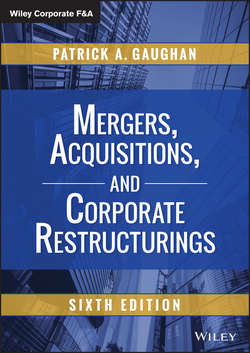Читать книгу Mergers, Acquisitions, and Corporate Restructurings - Gaughan Patrick А. - Страница 4
На сайте Литреса книга снята с продажи.
Preface
ОглавлениеTHE FIELD OF MERGERS and acquisitions has undergone tumultuous changes over the past 20 years. The 1990s witnessed the fifth merger wave – a merger wave that was truly international in scope. After a brief recessionary lull, the merger frenzy began once again and global megamergers began to fill the corporate landscape. This was derailed by the subprime crisis and the Great Recession. When the economic recovery was slow, so too was the rebound in M&A activity. However, by 2013 and 2014 M&As began to rebound more strongly.
Over the past quarter of a century we have noticed that merger waves have become longer and more frequent. The time periods between waves also has shrunken. When these trends are combined with the fact that M&A has rapidly spread across the modern world, we see that the field is increasingly becoming an ever more important part of the worlds of corporate finance and corporate strategy.
As the M&A field has evolved we see that many of the methods that applied to deals of prior years are still relevant, but new rules are also in effect. These principles consider the mistakes of prior periods along with the current economic and financial conditions. It is hoped that these new rules will make the mergers of the future sounder and more profitable than those of prior periods. However, while dealmakers have asserted that they will pursue such goals, we would be remiss if we did not point out that when deal volume picked up dramatically such intentions seemed to fall by the wayside and M&A mistakes started to occur. In fact, as with many other areas of finance, learning from past mistakes proves challenging. Lessons that are learned tend to be short-lived. The failures of the fourth merger wave were so pronounced that corporate decision makers loudly proclaimed that they would never enter into such foolish transactions. However, there is nothing like a stock market boom to render past lessons difficult to recall while bathing in the euphoria of rising equity values.
The focus of this book is decidedly pragmatic. We have attempted to write it in a manner that will be useful to both the business student and the practitioner. Since the world of M&A is clearly interdisciplinary, material from the fields of law and economics is presented along with corporate finance, which is the primary emphasis of the book. The practical skills of finance practitioners have been integrated with the research of the academic world of finance. In addition we have an expanded chapter devoted to the valuation of businesses, including the valuation of privately held firms. This is an important topic that usually is ignored by traditional finance references. Much of the finance literature tends to be divided into two camps: practitioners and academicians. Clearly, both groups have made valuable contributions to the field of M&As. This book attempts to interweave these contributions into one comprehensible format.
The increase in M&A activity has given rise to the growth of academic research in this area. In fact, M&A seems to generate more research than other areas of finance. This book attempts to synthesize some of the more important and relevant research studies and to present their results in a straightforward and pragmatic manner. Because of the voluminous research in the field, only the findings of the more important studies are highlighted. Issues such as shareholder wealth effects of antitakeover measures have important meanings to investors, who are concerned about how the defensive actions of corporations will affect the value of their investments. This is a good example of how the academic research literature has made important pragmatic contributions that have served to shed light on important policy issues. It is unfortunate that corporate decision makers are not sufficiently aware of the large body of pragmatic, high-quality research that exists in the field of M&A. One of the contributions we seek to make with this book is to render this body of pragmatic research readily available, understandable, and concisely presented. It is hoped then that practitioners can use it to learn the impacts of the deals of prior decision makers.
We have avoided incorporating theoretical research that has less relevance to those seeking a pragmatic treatment of M&As. However, some theoretical analyses, such as agency theory, can be helpful in explaining some of the incentives for managers to pursue management buyouts. Material from the field of portfolio theory can help explain some of the risk-reduction benefits that junk bond investors can derive through diversification. These more theoretical discussions, along with others, are presented because they have important relevance to the real world of M&As. The rapidly evolving nature of M&As requires constant updating. Every effort has been made to include recent developments occurring just before the publication date. We wish the reader an enjoyable and profitable trip through the world of M&As.
Patrick A. Gaughan
